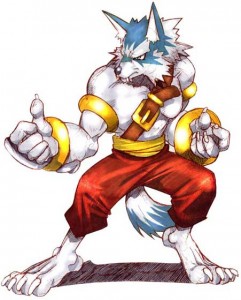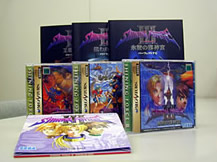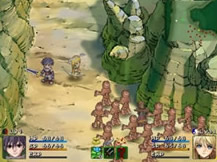Very few RPG series stand the test of time. Sure, a few sequels might spring up here and there over the course of a few years, but how many of them last for over a decade? I can think of a couple, like Final Fantasy, Dragon Warrior, Zelda, and perhaps a few others. These all have their charm and place in gaming history, to be sure. There is one franchise, however, that while not exactly a series per se, it has endured in one incarnation or another for almost fifteen years.
 The games in the Shining series are multiple (fourteen unique releases, to be exact, with two on the way) and have spanned numerous consoles, not all of them Sega’s. From the first title, the Genesis classic Shining in the Darkness to the most recent releases of Shining Soul on the Game Boy Advance, it has morphed itself and found a way to stay alive. This is especially admirable when you consider just how half-ass Sega has treated their RPG series over the year (Phantasy Star V, where are you?). Some were straight-up RPGs, others were action/RPGs, and still others were strategy/RPGs. Yes, the Shining franchise has done it all.
The games in the Shining series are multiple (fourteen unique releases, to be exact, with two on the way) and have spanned numerous consoles, not all of them Sega’s. From the first title, the Genesis classic Shining in the Darkness to the most recent releases of Shining Soul on the Game Boy Advance, it has morphed itself and found a way to stay alive. This is especially admirable when you consider just how half-ass Sega has treated their RPG series over the year (Phantasy Star V, where are you?). Some were straight-up RPGs, others were action/RPGs, and still others were strategy/RPGs. Yes, the Shining franchise has done it all.
Not bad for a name brand that has changed developers, survived disputes between its creators and Sega, and has even seen its release platform cancelled while still in development.
Developer History
Many people believe that the entire series was handled by a single developer. While this is partially true (Camelot Software Planning’s Hiroyuki Takahashi and Yasuhiro Taguchi have had a hand in every one of the games in the series, save the two Shining Soul titles), there still remains much confusion as to who did what, exactly. Bear with me as I try to sort this mess out and make something sane out of it.
Brothers Hiroyuki and Shugo Takahashi were programmers for the company Climax and began at Sega under the developer name “Sonic Co.” (also known as “Team Sonic” or “Sonic Software Planning”) and were responsible for creating both Shining in the Darkness and Shining Force. As there were only four people working on these titles, assistance was needed. The Takahashi brothers asked their former colleagues at Climax to help out with technical support. Mr. Naito (now head of Climax) directed and Hiroyuki Takahashi produced. This explains why both these titles had credits for Sega and Climax.
Still with me? Good.
Once both games were released, Sonic Software Planning went solo. The name “Camelot Software Planning” was only used when they developed games for other companies, like PlayStation’s Beyond the Beyond or various Mario sports titles for Nintendo. Sega finally allowed them to use the Camelot title when the third episode of Shining Force III for Saturn was in development. As fate would have it, that also was around the time that Camelot and Sega parted ways. It seems that the developers were understandably miffed by Sega’s decision to can the Saturn and concentrate on Dreamcast, effectively leaving Camelot high and dry and Shining Force III as a consolation prize for Saturn owners. In fact, the release of Shining Force III for the American Saturn was viewed by the company (particularly then-president Bernie Stolar) as a final “thank you” to fans, and the game appeared alongside such other hard to find gems as Panzer Dragoon Saga.
The Shining Force III premium disc, an extremely rare giveaway obtained by sending in the proofs of purchase from all three scenarios, had an “abstract.txt.” file in it that expressed Camelot’s disappointment with Sega’s actions.:
As we come nearer and nearer to the last stage of Sega Saturn, the difference between Sega’s and Camelot’s motto in making games increases more and more. This became even more obvious after Dreamcast’s launch. I sincerely wish people would not focus too much on graphics and forgot the essence of a game. What Camelot wants to make, is still “a game that’s really a game.” No matter how good a console can become, the essence of game will not change.
Sad, ain’t it?
For this reason, no more Shining titles were handled by Camelot. The two GBA releases of Shining Soul have been done by Sega themselves, with the aid of Salamander Factory, a company founded by Yoshitaka Tamaki (the character designer for Shining & the Darkness and the first Shining Force).
The Games
Renowned for their great characters and multiple styles of gameplay, the Shining games have come a long way. Beginning in 1991 with the second big Genesis RPG (after Phantasy Star II), Shining in the Darkness ushered in a new and wonderful universe of heroes and villains. Though many gamers complained of the lack of outdoor environments (the whole game takes place in a multi-level dungeon, hence the name Shining in the Darkness), there was more than enough diversity and excitement for all. Who could forget the first time that huge crab came out from around the corner and blocked your path or those enemies that called for help just when you thought they were beaten?
One enduring element that SitD implemented was the menu system. Tiny animations accompanied the text, making each and every action very easy and intuitive. This system was so effective, in fact, that it can be found in just about every game in the series, as well as Beyond the Beyond and Golden Sun on the GBA.
SitD was given a pseudo-sequel on Saturn with Shining the Holy Ark. Using rendered characters instead of sprites (a technique also used in Shining Force III, Shining Wisdom, and Golden Sun), the game was 45+ hours of pure dungeon crawling bliss. An ungodly soundtrack accompanied you on your adventure, which was in every way reminiscent of Darkness. This time, however, there were outdoor environments, character class upgrades, even ninjas!
 Not a just one-trick pony, Camelot also created the granddaddy of console strategy/RPGs, Shining Force. Spawning sequels on the Genesis, Game Gear, and Saturn, the franchise is has already made an impact on the GBA with the re-release of the Genesis original (titled Resurrection of Dark Dragon) and has also made a big comeback on PS2 recently. Combining the excellent menu system from Darkness with incredible battle animations and multiple classes, the game quickly became a fan favorite. Both the Game Gear Gaiden titles were re-released on the Sega CD in a single, combined adventure named Shining Force CD, that even had an exclusive extra battle at the end that allowed you to choose from all 24 characters from both quests! You needed to have the Sega CD RAM cart to access it though. The third GG release, Final Conflict remains a Japanese exclusive and goes for quite a bit on eBay. Shining Force III on Saturn was divided into three separate adventures, each released individually. Sega, in its infamous daze, passed on the last two scenarios, essentially leaving U.S. gamers with 33% of the story.
Not a just one-trick pony, Camelot also created the granddaddy of console strategy/RPGs, Shining Force. Spawning sequels on the Genesis, Game Gear, and Saturn, the franchise is has already made an impact on the GBA with the re-release of the Genesis original (titled Resurrection of Dark Dragon) and has also made a big comeback on PS2 recently. Combining the excellent menu system from Darkness with incredible battle animations and multiple classes, the game quickly became a fan favorite. Both the Game Gear Gaiden titles were re-released on the Sega CD in a single, combined adventure named Shining Force CD, that even had an exclusive extra battle at the end that allowed you to choose from all 24 characters from both quests! You needed to have the Sega CD RAM cart to access it though. The third GG release, Final Conflict remains a Japanese exclusive and goes for quite a bit on eBay. Shining Force III on Saturn was divided into three separate adventures, each released individually. Sega, in its infamous daze, passed on the last two scenarios, essentially leaving U.S. gamers with 33% of the story.
One key element in all the Shining games is that they are all inter-related in some way. For example, the storyline in Shining the Holy Ark leads directly into Shining Force III and even includes references to characters from the first Shining Force title. Characters in the second Force title are also featured in Shining Wisdom.
Speaking of Shining Wisdom, it’s interesting to note that this is the only Shining title not released in the U.S. by Sega. Working Designs handled the publishing duties here. Going off in another direction entirely, Wisdom was an action/RPG akin to The Legend of Zelda. You play Mars, son of the legendary warrior Jiles, who must stop the Black Elf Pazort from reviving the god-like Dark Titian from the abyss to rule the world. Although not one of the more popular titles in the series, Wisdom wasn’t a bad game at all. Moreover, it is the only game in the group to receive the Working Designs release treatment, complete with foil cover and disc art.
Both Shining Soul games, though not done by the original developers, are still tied to the universe. The first title deals with the final battle against the Dark Dragon, the final foe in the original Shining Force. Essentially a multi-player action/RPG, it has the unique feature of allowing up to four gamers to connect and play together. Being the first game not done by the Takahashi brothers, however, the lack of quality in both the plot and gameplay obscure what could have been an innovative and fun twist to the already established style of play. The sequel improved upon the flaws of the first game and has redeemed Sega’s new Shining line to some degree. Fans of the series prepare yourself, because it appears that Camelot is done with the series for the foreseeable future.
2004 saw the first of two new additions to the family. The first, Shining Tears, is an action/RPG that attempts another new twist on gameplay by allowing you to control two characters at once. Released late last year, it has met with something of a lukewarm reception from the press and public. Heavily criticized for its simplistic focus on action over RPG elements, many argue that it strays far too much from the treasured formula that characterizes the franchise. There’s no denying that it looks marvelous, but the Shining games have always been about that delicate balance between presentation and solid gameplay, which is something that perhaps wasn’t achieved with Tears.
The latest entry, Shining Force NEO, seems to have refined the action/RPG dynamic enough to really make it work well. After several attempts, it seems that Sega has finally discovered how to make this genre work. The story may seem a bit cliche (boy warrior is thrust into the role of savior over an impending evil), but it plays like a dream. The stylish and lush graphics are complimented by some solid and intuitive gameplay, making it not only one of the better Shining games released recently, but perhaps one of Sega’s best offerings in recent years overall. The only real major complaint people seem to have with it is the use of the Force name, since all strategy elements of past titles has been stripped away. NEO plays more like an Ys game than Shining Force, and lends further evidence to the theory that Sega may be striving to take the series in a more Final Fantasy-like direction, where all releases share only the title. This would be most unfortunate, since the common universe shared by all the games is a huge part of their appeal.
The Adventure Continues…
 It gives me a warm and fuzzy feeling inside to see that the Shining games are alive and well. With the recent surge of interest in classic gaming and older franchises, Sega is wise to keep it going, especially when the level of quality done by the Takahasi Bros and Camelot has always been consistent. It would be nice to get those last two scenarios from Shining Force III released here, but that still seems like a pipe dream.
It gives me a warm and fuzzy feeling inside to see that the Shining games are alive and well. With the recent surge of interest in classic gaming and older franchises, Sega is wise to keep it going, especially when the level of quality done by the Takahasi Bros and Camelot has always been consistent. It would be nice to get those last two scenarios from Shining Force III released here, but that still seems like a pipe dream.
It remains to be seen just how well the current generation of gamers embrace the latest batch of games but I have no doubt that they will show the love and make both Shining Tears and the new Shining Force big successes. Sound overly optimistic? Perhaps, but that’s the way things go sometimes. Time will be the one to tell if I’m right and time has always been good to the Shining string of games, so things are definitely in their favor.
The complete chronology is as follows (dates alone are for domestic releases):
- Shining in the Darkness, Genesis (1991)
- Shining Force, Genesis (1991)
- Shining Force Gaiden, Game Gear (Japan, 1992)
- Shining Force Gaiden II: Sword of Hajya, Game Gear (Japan, 1993)
- Shining Force II: Seal of the Ancients, Genesis (1994)
- Shining Force CD, Sega CD (1995)
- Shining Force Gaiden: Final Conflict, Game Gear (Japan, 1995)
- Shining Wisdom, Saturn (1996)
- Shining the Holy Ark, Saturn (1996)
- Shining Force III, Saturn (1998)
- Shining Force III: Episode 2, (Japan, April 1998)
- Shining Force III: Episode 3, (Japan, Spet. 1998)
- Shining Force III: Premium Disc, (Japan, Dec. 1998)
- Shining Soul, Game Boy Advance (2003)
- Shining Soul II, Game Boy Advance (2004)
- Shining Force: Resurrection of Dark Dragon, Game Boy Advance (2004)
- Shining Tears, PlayStation 2 (2004)
- Shining Force NEO, PlayStation 2 (2005)
- Shining Road to the Force, FOMA900/901 Series Mobile Phone (2005)
- Shining Force Chronicle, FOMA900/901 Series Mobile Phone (2005)
- Shining Wind, PlayStation 2 (2007)
- Shining Force EXA, PlayStation 2 (2007)
Sources
- “Developers Behind the Shining Series.” Shining Force Central, 2001-2004.
- Developer Info. Camelot Site, Dec. 23, 2003.

Recent Comments